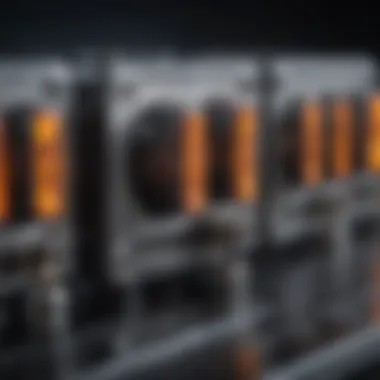Understanding 0.00 Power Contacts in Electrical Systems


Intro
In the domain of electrical systems, the concept of 0.00 power contacts represents a transformative approach to energy management. These contacts enable devices to significantly reduce power consumption while maintaining performance. Understanding their role is essential for professionals, researchers, and students engaged with energy-efficient technologies. This article aims to elucidate the significance of 0.00 power contacts through thorough examination and context exploration.
Research Overview
Summary of Key Findings
The analysis of 0.00 power contacts reveals several critical findings:
- Definition: 0.00 power contacts are designed to ensure minimal energy leakage, which is pivotal in enhancing efficiency.
- Applications: They find utility across various fields like consumer electronics, electrical engineering, and smart home devices.
- Impact on Sustainability: These contacts contribute positively towards reducing a device's overall carbon footprint.
Relevance to Current Scientific Discussions
The discussion surrounding energy efficiency is more pertinent than ever. With increasing emphasis on sustainable practices, 0.00 power contacts have emerged as a focal point in current scientific dialogues. Their integration into modern electrical design aligns with ongoing efforts to enhance energy conservation. Researchers constantly seek innovative solutions to pressing environmental challenges, making this topic timely and relevant.
Methodology
Research Design and Approach
The examination of 0.00 power contacts involved a multi-faceted research design. Both qualitative and quantitative methodologies were employed to gather comprehensive insights. Case studies from various industries highlighted successful implementations.
Data Collection and Analysis Techniques
Data was collected through:
- Surveys distributed among electrical engineers and designers.
- Analysis of case studies demonstrating effective use of these contacts.
- Review of academic articles and technical papers discussing related technologies.
This approach allowed for a robust understanding of practical applications as well as theoretical implications.
"Understanding low-power technologies like 0.00 power contacts is key to shaping the future of energy management."
As the article progresses, more detailed analyses will delve into their applications and effectiveness in various settings, revealing how they serve as a cornerstone for sustainable electrical practices.
Prelude to Electrical Contacts
The area of electrical contacts is foundational in electrical engineering and systems. Understanding electrical contacts is vital for grasping how power flows within circuits and the efficiency of devices themselves. Contacts play a crucial role in completing circuits, ensuring that electrical current travels from one point to another effectively. This knowledge becomes even more important in the context of low-power technologies, such as 0.00 power contacts, which prioritize energy conservation while maintaining functionality.
Recognizing the importance of electrical contacts centers on several key aspects:
- Energy Efficiency: Properly designed contacts can significantly reduce energy loss, contributing to overall system efficiency.
- Reliability: The reliability of connections impacts the performance of electrical systems. Poor contact can lead to failures.
- Standards and Safety: Understanding contact specifications helps in following industry standards, ensuring safety in operations.
This section sets the stage for exploring how these contacts function within circuits, with an emphasis on their design and operational values that ultimately affect voltage, current ratings, and performance. Hence, a comprehensive understanding of electrical contacts prepares us to dive deeper into specific concepts related to power measurement and low-power technologies.
Understanding Power Measurement
Understanding power measurement is vital for grasping the concept of 0.00 power contacts in electrical systems. Power measurement serves as a foundation for evaluating electrical system performance. It influences design decisions, efficiency assessments, and long-term sustainability strategies in both industrial and consumer applications.
Basic Principles of Power Calculation
Power calculation fundamentally involves determining the rate at which energy is transferred or converted. In electrical systems, this is typically expressed through the formula:
Power (P) = Voltage (V) × Current (I)
This equation can seem straightforward but has deeper implications when considering different types of power, such as active, reactive, and apparent power.


- Active Power (P) is the power that performs useful work, measured in watts (W).
- Reactive Power (Q), measured in reactive volt-amperes (VAR), does not perform useful work but is essential for establishing magnetic fields in inductive loads.
- Apparent Power (S) is the combination of active and reactive power, measured in volt-amperes (VA).
By understanding these principles, it is clear why accurate measurement is critical in minimizing energy losses and ensuring efficient system designs.
Significance of Power Ratings
Power ratings provide a benchmark for the performance capabilities of electrical components and systems. They indicate how much energy a device can handle safely, which is essential for both safety and operational efficiency. Understanding power ratings helps in selecting appropriate components for specific applications.
Key considerations include:
- Load management: Evaluating power ratings assists in preventing overloads.
- Heat management: Higher power ratings typically lead to increased heat generation. Thus, efficient thermal management is necessary.
- System integration: Knowing power ratings aids in integrating different devices within an electrical system without risking failure.
Research shows that failure to consider power ratings can lead to underperformance or catastrophic system failures. Therefore, it is essential for students, educators, and professionals in the field to familiarize themselves with the principles of power measurement and their practical implications.
What Does 0. Power Contacts Mean?
The concept of 0.00 power contacts plays a significant role in modern electrical systems. These contacts refer to components that operate with extremely low or negligible power consumption. This aspect is particularly vital for enhancing energy efficiency and minimizing waste in various applications. Understanding 0.00 power contacts is crucial for students, educators, researchers, and professionals in electrical engineering and technology. They represent the shift toward minimizing energy use without sacrificing performance. With continuous innovations in technology, grasping this concept helps navigate complex systems that prioritize sustainability.
Technical Interpretation
From a technical standpoint, 0.00 power contacts are characterized by their ability to facilitate electrical connectivity while consuming little to no power during their operation. This low power consumption can be attributed to advanced materials and designs employed in their construction. They utilize resistive, capacitive, or magnetic principles to minimize the energy draw when in active or passive states.
For instance, these contacts may be incorporated in devices such as sensors, relays, or any electronic circuitry that requires minimal activation energy. Thus, the accuracy in measuring parameters, such as voltage and current, translates to better overall efficiency in electrical systems. The technical interpretation encompasses the understanding of these components’ functioning at near-zero power levels, paving the way for innovations in low-power applications.
Impact on Energy Consumption
The impact of 0.00 power contacts on energy consumption is profound. By implementing contacts designed for low power, devices can significantly reduce the amount of energy required for operation. This reduction translates not just into cost savings but also into a lower carbon footprint. In commercial and residential settings, the resultant energy efficiency creates a ripple effect in overall energy management strategies.
Key benefits include:
- Reduced Operating Costs: Lower energy consumption directly translates into financial savings over time, especially in high-use environments.
- Enhanced Device Lifespan: Components that operate with less strain often have longer operational lives, contributing to sustainability.
- Improved Performance Metrics: Devices can run more efficiently, maintain higher performance standards, and offer greater reliability.
Importantly, the transition to utilizing 0.00 power contacts can also encourage manufacturers to rethink their designs and production methods, prioritizing energy efficiency in every aspect of their products.
"The shift to low-power technologies is not just an option; it's a necessity for a sustainable future."
Overall, 0.00 power contacts signify a step toward more responsible energy usage in technology. These insights are invaluable for advancing research and development in the field of electrical engineering. They emphasize the importance of integrating such technologies into modern systems.
Applications of 0. Power Contacts
The application of 0.00 power contacts is pivotal in various domains. Understanding how these contacts function and where they are utilized is essential for grasping their broader relevance in today's technology-driven world. As electronic devices become more energy-efficient, the role of power contacts, specifically those designed to operate with virtually no energy consumption, is becoming increasingly important.
In consumer electronics, 0.00 power contacts facilitate the development of smarter gadgets that reduce energy usage. This capability not only lowers electricity bills but also contributes to eco-friendly practices. With these contacts, manufacturers can design devices that remain in a standby mode without consuming any significant power, addressing one of the biggest challenges in energy management.
Industry is also seeing great importance in 0.00 power contacts. These contacts are critical components in various industrial equipment, where efficiency is paramount. Usage in machinery that monitors or automates processes ensures that energy does not wasteily leak during idle periods. Hence, leveraging 0.00 power technology can significantly reduce operational costs.
In summary, the applications of 0.00 power contacts lie at the intersection of innovation and sustainability. They drive the development of energy-efficient devices across consumer and industrial sectors, marking a significant advancement in electrical technology. Recognizing these applications provides a clear insight into how low-power solutions contribute to both economic efficiency and environmental sustainability.
Use in Consumer Electronics
The consumer electronics market is rapidly evolving. The integration of 0.00 power contacts allows for more innovative designs without compromising energy efficiency. Devices such as smart thermostats and energy-efficient appliances leverage these contacts to conserve energy. They switch to low power modes when not in active use, addressing the critical issue of standby power consumption, often referred to as vampire power.


Moreover, these contacts enable remote operation for devices while maintaining minimal energy usage. Consumers can enjoy functionalities from their gadgets without the fear of excessive energy bills. This transformation is not just about convenience; it has the potential to reduce the carbon footprint associated with electronics.
Role in Industrial Equipment
In the realm of industrial operations, 0.00 power contacts are vital for enhancing energy efficiency. Industries are under constant pressure to reduce costs and emissions. By implementing these low-power contacts, automation systems can operate efficiently, consuming the least amount of energy while maximizing performance.
For example, in manufacturing plants, machine sensors equipped with 0.00 power contacts can monitor operations without drawing unnecessary power. This feature is essential, especially in processes where equipment is frequently idle. Additionally, machines with these contacts can undergo routine diagnostics without significant energy drain, further contributing to ongoing efficiency.
Using 0.00 power contacts encourages industries to adopt more sustainable practices. It also aligns with global initiatives aimed at promoting energy conservation. The adoption of such innovative solutions reflects a commitment to fostering a greener future while maintaining productivity.
Advantages of Low-Power Technologies
Low-power technologies represent a fundamental shift in how electrical systems are designed and operated. These advancements not only enhance the performance metrics of various devices but also align with a global movement toward energy efficiency and sustainability. As society continues to grapple with the environmental consequences of energy consumption, the implementation of low-power systems becomes increasingly vital.
Energy Efficiency Benefits
One of the core merits of low-power technologies is their ability to optimize energy efficiency. Devices equipped with 0.00 power contacts consume significantly less energy compared to traditional models. This reduction in power consumption manifests in various ways:
- Reduced Operating Costs: Since low-power devices require less electricity to function, the savings in energy bills can be substantial, contributing directly to a reduced total cost of ownership.
- Extended Device Lifespan: Many low-power systems generate less heat, which minimizes thermal stress on components. This longevity not only saves costs on replacements but also ensures consistent performance over time.
- Efficient Resource Utilization: The implementation of low-power technologies often leads to improved overall efficiency in systems, allowing for better utilization of existing energy resources.
The importance of these benefits is underscored when assessing large-scale implementations in sectors like telecommunications, computing, and transportation. The effective design of low-power systems results in an aggregated benefit that can mean substantial reductions in energy demands across entire industries.
Environmental Implications
The environmental implications of adopting low-power technologies are profound. A transition to 0.00 power contacts directly correlates with decreased carbon footprints and resource conservation. Some key aspects include:
- Lower Greenhouse Gas Emissions: By consuming less power, low-power devices contribute to a decrease in greenhouse gases emitted during electricity production, particularly from fossil fuels.
- Conservation of Resources: It takes fewer resources to manufacture and maintain low-power devices. This conservation extends to the raw materials used in production, as reduced energy consumption can lessen the need for extraction and processing.
- Support for Renewable Energy Sources: Low-power technologies often complement renewable energy systems. Devices that function efficiently on less energy are better suited to operate in environments where energy availability may fluctuate, such as solar or wind-power setups.
Ultimately, the shift toward low-power technologies not only makes economic sense but also serves a broader purpose in environmental stewardship. The integration of these systems marks a step forward, particularly in responding to the pressing challenges of climate change and sustainable development.
"Investing in low-power technologies is not merely a cost-saving initiative; it is an essential strategy for fostering a sustainable future."
Challenges and Limitations
Understanding the challenges and limitations of 0.00 power contacts is vital for both designers and engineers working with modern electrical systems. These contacts, while providing significant advantages in terms of energy efficiency and minimized heat generation, also present obstacles that must be acknowledged and addressed in practice.
One primary element of concern is performance under load. This aspect highlights how these contacts react when subjected to various electrical loads during operation. Unlike traditional power contacts, 0.00 power contacts can struggle with maintaining consistent performance, especially in high-demand environments. They may exhibit greater resistance or a propensity to fail when the electrical load exceeds their designed specifications. This potential for performance degradation underscores the need for thorough testing and validation in the intended application. Without proper measures, the very benefits of energy efficiency can be overshadowed by reliability concerns.
The balance between energy efficiency and operational reliability is critical in ensuring the effective use of 0.00 power contacts.
Another significant limitation lies in manufacturing and design constraints. As the market for low-power technologies expands, the demand for precise and specialized manufacturing processes increases concurrently. Achieving the required specifications for 0.00 power contacts often necessitates high-quality materials and advanced production techniques, which can elevate costs and complicate the design.
These constraints can lead to increased lead times and potential difficulties in scaling production to meet market needs. As a result, engineers must navigate a careful balance: designing devices that incorporate 0.00 power contacts while also considering manufacturability and cost-effectiveness. This interplay between innovative design and practical constraints poses a consistent challenge in fully utilizing the benefits of this technology.
In summary, recognizing the challenges and limitations of 0.00 power contacts is essential for ensuring their effective application in both consumer electronics and industrial equipment. Understanding performance under load and navigating manufacturing hurdles will be crucial for future advancements and widespread adoption.
Future Trends in Low-Power Technology
As the demand for energy efficiency grows, the exploration of future trends in low-power technology becomes increasingly vital. These advancements aim to optimize power consumption, extend the lifespan of devices, and contribute to sustainability. In this context, understanding the trajectory of innovations in 0.00 power contacts can offer valuable insights into the changing landscape of electrical systems.
Emerging Designs and Innovations


Emerging designs in low-power technologies focus on miniaturization and smart functionality. These designs leverage materials that can operate effectively at lower power levels, which reduces waste. For instance, the development of nano-materials enhances energy efficiency significantly. One innovative approach involves the integration of smart sensors. These sensors adjust power usage based on real-time needs, effectively limiting unnecessary energy consumption.
Another key innovation is seen in solid-state circuits. Unlike traditional circuits, solid-state devices consume very low power, greatly extending battery life in consumer electronics. Furthermore, manufacturers are increasingly adopting energy harvesting methods. These methods draw ambient energy from the environment, allowing devices to operate without constant external power. The dimension and configuration of components are also optimized to improve energy performance.
"The advances in low-power technology illuminate a path toward sustainable energy consumption that was previously thought unattainable."
Research Directions in Electrical Engineering
Current research in electrical engineering is increasingly directed towards low-power technology. Studies often focus on energy conversion efficiencies and demand-side management strategies, which target reductions in overall energy usage. Researchers are also working on enhancing power electronics, which manage electrical energy flow. Innovations here could lead to significant breakthroughs in how devices handle power transitions without sacrificing performance.
The exploration of quantum computing is also on the rise. This field holds the promise of solving complex problems with exceptionally low energy requirements. Furthermore, incorporating machine learning algorithms can enable systems to predict power usage trends and adaptively optimize performance.
These research directions signify a greater commitment to sustainability within electrical engineering. As more institutions, such as universities and industry leaders, invest in this area, the potential for transformative change becomes clearer.
Case Studies Examing 0. Power Applications
Case studies provide a valuable lens through which the practical applications and implications of 0.00 power contacts can be understood. These real-world examples highlight the importance of low-power technologies and their role in enhancing efficiency and sustainability. In this section, we will explore two prominent areas: smart devices and renewable energy systems. Through these case studies, the specific benefits, strategies, and considerations of employing 0.00 power contacts will become evident.
Application in Smart Devices
Smart devices have become ubiquitous in modern life. They utilize 0.00 power contacts to improve energy efficiency, which is essential in battery-operated gadgets. For instance, devices such as smartwatches and fitness trackers often rely on minimal energy usage to prolong battery life. The incorporation of 0.00 power technology allows these devices to function effectively while consuming little energy.
One notable application is in Bluetooth-enabled devices, where maintaining a connection without drawing excessive power is crucial. Brands like Apple and Fitbit have implemented this technology, resulting in longer-lasting devices. Using 0.00 power contacts helps reduce the energy footprint of these devices, thereby contributing to sustainable consumption.
Key aspects include:
- Extended Battery Life: Devices operate longer, benefitting users directly.
- Device Efficiency: Energy savings enhance overall functionality without sacrificing performance.
- Environmental Impact: Reduced energy usage aids in sustainable practices.
Utility in Renewable Energy Systems
Renewable energy systems represent another field where 0.00 power contacts play a critical role. In solar power installations, these contacts are used in monitoring systems that require continuous operation without high power demands. For example, smart inverters incorporate 0.00 power technology to ensure precise energy management while maintaining optimal performance.
The use of such technology in renewable setups allows for:
- Real-Time Monitoring: Enables timely data collection for analysis and optimization.
- Lower Operational Costs: Reducing power consumption leads to cost efficiency.
- Enhanced Reliability: Ensuring that critical systems remain operational with minimal energy requirements is essential.
By analyzing these applications, it becomes clear that 0.00 power contacts bring significant advantages. They not only optimize the performance of devices and systems, but they also contribute to broader environmental goals.
"The transition to low-power solutions marks an essential step towards sustainability in technology and energy."
As such, case studies fuel our understanding of how these contacts can influence future designs while meeting contemporary energy demands.
The End and Implications for Research
The exploration of 0.00 power contacts holds significant relevance in today's energy-conscious environment. The findings of this article emphasize the essential role that these contacts play in optimizing energy efficiency across various applications. As energy demands evolve, understanding how effectively these components function in different systems can lead to significant advancements in technology and sustainability.
Summary of Findings
0.00 power contacts are a pivotal element in electric circuits, minimizing energy loss while maximizing functionality. Their ability to operate at near-zero power consumption enhances devices without sacrificing performance. Key findings from our analysis include:
- Energy Management: These contacts facilitate better power management systems, leading to overall reduced emissions and energy costs.
- Variable Applications: The adaptability of 0.00 power contacts spans various sectors, from industrial equipment to smart consumer electronics.
- Sustainable Practices: Adoption of these technologies contributes to broader environmental goals, emphasizing the importance of energy-saving strategies in engineering projects.
This diverse applicability underlines the value of further research into 0.00 power technology, potentially leading to innovations that push the boundaries of current electrical systems.
Recommendations for Future Work
It is crucial to foster ongoing research and development focused on 0.00 power contacts. Future studies could explore several aspects, including:
- Performance Optimization: Investigate advanced materials and designs that might further enhance efficacy in various applications.
- Integration in Smart Grids: Examine how 0.00 power contacts can be integrated into smart grid technologies, improving efficiency and responsiveness in energy distribution.
- Longitudinal Studies: Conduct extensive empirical studies on the long-term benefits of implementing these contacts in various applications to quantify energy savings and performance improvements.



